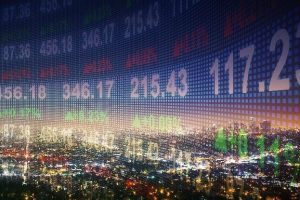To determine whether a stock is cheap or expensive, investors generally use the price to earnings (P/E) ratio. Historical information can be used to compare how expensive a company is in comparison to how the share price has traded over time. Price per earnings can also be compared to other stocks in same industry. That way we can also determine whether individual stocks are expensive relative to their peers.
What is the P/E ratio?
The price per earnings formula is the current price of the stock divided by the earnings per share. A low P/E indicates the investor is paying less for the earnings. The ratio can represent the number of years after purchase to recoup an investment in that particular share. Earnings per share (EPS) is needed to calculate the P/E ratio. EPS is usually calculated from the last four quarters.
A high P/E can indicate investors are expecting higher earnings growth in the future. P/E is what investors are willing to pay per dollar of earnings. If the P/E is 20, then the investor is willing to pay $20 for $1 of current earnings. It also can mean it would take 20 years earnings to recover the price paid for the stock. Companies with no earnings will not have a P/E ratio. PE ratios can only be calculated on companies with earnings.
Comparing P/E ratios to historical records
If we use the P/E ratio as a gauge of whether a company is expensive or not and average that for the overall market, then the ratio of the Australian market is usually said to be about 15 times. The current S&P/ASX 200 P/E ratio is 17.57. This can indicate investors are expecting earnings per share to grow in the future and are willing to pay a premium for the shares. However, although the PE ratio is high for the overall market, it may tell a different story if we look at individual stocks and different industries.
Comparing P/E between stocks
If we look at A2 Milk (ASX:A2M), the latest P/E ratio is 26.27. The industry average P/E is 21.96 which means that A2M is expensive compared to the industry average. It is also expensive compared to the overall market.
If we look at Bluescope (ASX:BSL), the latest P/E ratio is 11.56 where the industry average for materials is 14. These figures also indicate that Bluescope is trading under the overall market average. Because of this, BSL is cheap compared to its industry and the overall market average.
In the example of A2M, the stock is expensive but investors are confident the company will continue to generate strong earnings growth. They are therefore willing to pay a premium for that price.
Asset class returns
When you look at equity returns in comparison to other asset classes such as property, bond and cash, the share market has returned the highest in the last year. The S&P/ASX 200, at time of writing, has returned 7.8% in the last 12 months (excluding dividends). At the moment, cash is earning an interest rate of 1.5% and Sydney property prices have declined 5.6% in the last 12 months. From these figures the stock market looks like it is generating the best return for now. It may be expensive on a historical basis, but it is the asset class delivering the growth for the time being.
Lauren Hua is a private client adviser at Fairmont Equities.
Sign up to our newsletter. It comes out every week and its free!
Would you like us to call you when we have a great idea? Check out our services.
Disclaimer: The information in this article is general advice only. Read our full disclaimer HERE.
Like this article? Share it now on Facebook and Twitter!

